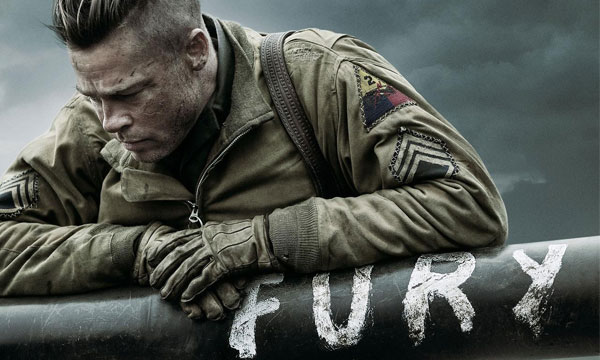Within the genre of war films lies a sub-genre devoted to anti-war war films, films that are so honest and earnest in their depiction of battle that they make us question our own sanity for ever sending women and men into such conditions. David Ayer‘s latest film, Fury, falls into that category.
April 1945. The war is winding down, but not before many more people have to die. Allied forces are taking heavy damage and casualties thanks to the superior German tanks and artillery. Don “Wardaddy” Collier (Brad Pitt) leads a tank unit of battle-hardened soldiers, Boyd “Bible” Swan (Shia LaBeouf), Trini “Gordo” Garcia (Michael Pena), Grady Travis (John Bernthal), and rookie Norman Ellison (Logan Lerman). Bible, Gordo, and Grady have killed Nazis with Wardaddy from Africa through Western Europe and now in Germany. They soldier on through unbelievably harsh conditions, experiencing horrific victories and various levels of defeat. Along with two other tank units, Wardaddy and his men are ordered to protect a vital crossroads. Along the way, a mighty German Tiger tank destroys the other two units, leaving Wardaddy and his men alone to face over 300 heavily-armed Nazi soldiers in an epic shootout.
Technically, Fury is a marvel. The sound effects and design make it feel like you’re inside the tank with these soldiers. The cinematography is as bleak as the subject matter deserves, capturing the harsh conditions in which these men lived and fought. The makeup artists are at their best here, heightening the actors’ haggard appearances. On par with Saving Private Ryan, the brutality of battles depicted in Fury belongs among the most gruesome war films of all time.
Two more notes on the setting of the film are worth mentioning. Writer/director Ayer explains:
It’s a different world from your usual war movie, where we celebrate victorious campaigns like the invasion of the European continent, or D-Day, or the Battle of the Bulge, these famous battles that American troops have taken part in. One of the forgotten time periods is this last gasp of the Nazi empire, with an American army that has been fighting for years and is on its last reserves of manpower. The men are exhausted. In World War II, you fought until you either won or died, or were grievously injured and got sent home.
It’s almost hard to believe, but everything that happens in the film only takes place over a 24-hour period. This end-of-the-war setting and the shorter time frame of the narrative heightens the emotional and psychological impact of the film.
And it is the emotional and psychological damage of war that is at the heart of Fury, thanks in part to some brilliant performances, particularly from LaBeouf, Berenthal, and Pena. I don’t know what Ayer did, but he got one of the best performance from LaBeouf that the young actor has ever delivered. As a fervently religious soldier, Bible shapes his experiences with theological assertions and quotations of scripture. But he’s not so confident in these beliefs that we don’t see the horrors of what he’s done and endured making room for some doubt. Grady also shares in Bible’s religion but is quicker to throw himself into the evils of war. He’s a fairly even-keel character in the sense that he was probably as tough, violent, and cynical before the war as he is when the body count escalates. We don’t doubt him for a second when he surveys his hellish surroundings and responds with a smile, “Best job I ever had.” Gordo seems like he’s taking it all in stride with a “This is what we’re here to do” attitude, but it feels like he could snap at any moment, medicating with alcohol as he does. Norman, as the last-minute replacement in the Fury tank (and point-of-entry into the narrative for many viewers), undergoes the most radical (and speedy) transformation from a relative pacifist to a bona-fide Nazi-killer.
Their fearless leader, Wardaddy, keeps his chiseled chin up. Although he can walk the moral high road no better than those under his command, he tries to rise above the chaos around him whenever possible. There’s a brilliant, though lengthy, scene in which Wardaddy and Norman quietly take over a flat belonging to two German women. He asks the older woman to cook a meal while he cleans up and shaves. Norman and the younger woman enjoy time alone in the adjoining bedroom. As the four of them sit down for their meal, Grady, Gordo, and Bible noisily invade the room and ruin the meal by telling a particularly brutal story about one of their past campaigns. They throw Wardaddy’s sense of propriety and superiority right back in his face by forcing him to remember their roles in the slaughter.
Fury raises numerous points about redemption, separation and assimilation, integrity, and good vs. evil, most of which I discuss in my interview with Ayer. There is a bleakness about Fury that a WWII film demands. Kevin Vance, one of the military technical advisers on the film, says, “In most World War II movies, we have this association with ‘the good war’–and it is–but over 60 million people died in World War II. That’s a dichotomy that hasn’t been fully explored, and that’s what David demanded of this film.” Fury, and other films like it that explore this reality, bring us back to that sub-genre of anti-war war films that might be traced all the way back to All Quiet on the Western Front. While Fury‘s unflinching representation of man-made death and destruction is not without some inconsistencies, it still forces us to question why we continue to walk such a destructive path.
Fury (135 mins.), rated R for strong sequences of war violence, some grisly images, and language throughout, opens in theaters everywhere October 17.

